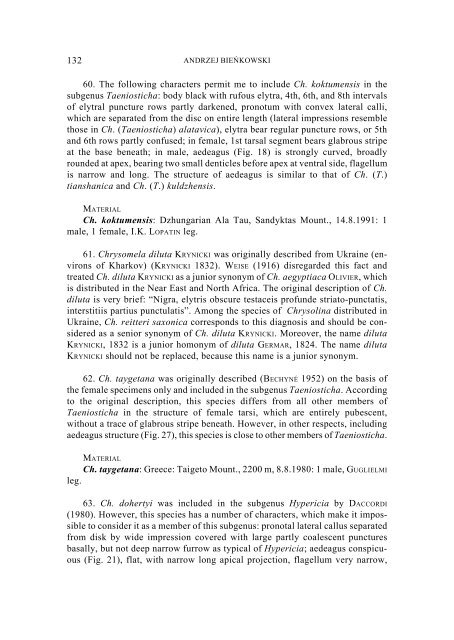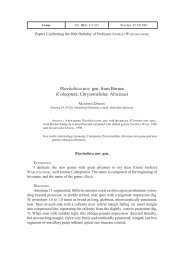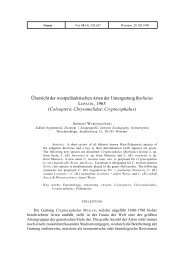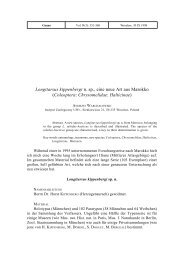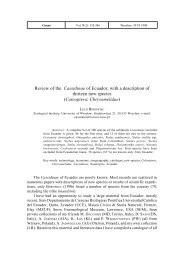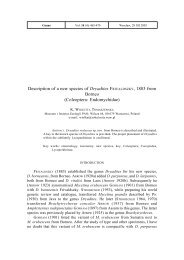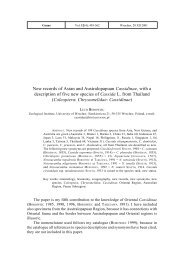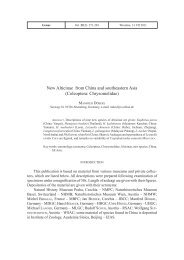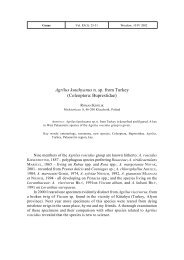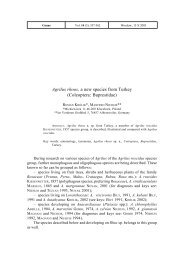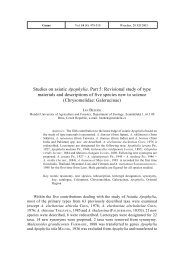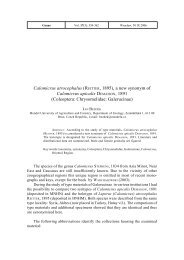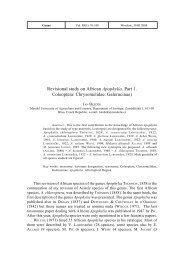A study on the genus Chrysolina MOTSCHULSKY, 1860, with a ...
A study on the genus Chrysolina MOTSCHULSKY, 1860, with a ...
A study on the genus Chrysolina MOTSCHULSKY, 1860, with a ...
You also want an ePaper? Increase the reach of your titles
YUMPU automatically turns print PDFs into web optimized ePapers that Google loves.
132 ANDRZEJ BIEÑKOWSKI<br />
60. The following characters permit me to include Ch. koktumensis in <strong>the</strong><br />
sub<strong>genus</strong> Taeniosticha: body black <strong>with</strong> rufous elytra, 4th, 6th, and 8th intervals<br />
of elytral puncture rows partly darkened, pr<strong>on</strong>otum <strong>with</strong> c<strong>on</strong>vex lateral calli,<br />
which are separated from <strong>the</strong> disc <strong>on</strong> entire length (lateral impressi<strong>on</strong>s resemble<br />
those in Ch. (Taeniosticha) alatavica), elytra bear regular puncture rows, or 5th<br />
and 6th rows partly c<strong>on</strong>fused; in female, 1st tarsal segment bears glabrous stripe<br />
at <strong>the</strong> base beneath; in male, aedeagus (Fig. 18) is str<strong>on</strong>gly curved, broadly<br />
rounded at apex, bearing two small denticles before apex at ventral side, flagellum<br />
is narrow and l<strong>on</strong>g. The structure of aedeagus is similar to that of Ch. (T.)<br />
tianshanica and Ch. (T.) kuldzhensis.<br />
MATERIAL<br />
Ch. koktumensis: Dzhungarian Ala Tau, Sandyktas Mount., 14.8.1991: 1<br />
male, 1 female, I.K. LOPATIN leg.<br />
61. Chrysomela diluta KRYNICKI was originally described from Ukraine (envir<strong>on</strong>s<br />
of Kharkov) (KRYNICKI 1832). WEISE (1916) disregarded this fact and<br />
treated Ch. diluta KRYNICKI as a junior syn<strong>on</strong>ym of Ch. aegyptiaca OLIVIER, which<br />
is distributed in <strong>the</strong> Near East and North Africa. The original descripti<strong>on</strong> of Ch.<br />
diluta is very brief: “Nigra, elytris obscure testaceis profunde striato-punctatis,<br />
interstitiis partius punctulatis”. Am<strong>on</strong>g <strong>the</strong> species of <strong>Chrysolina</strong> distributed in<br />
Ukraine, Ch. reitteri sax<strong>on</strong>ica corresp<strong>on</strong>ds to this diagnosis and should be c<strong>on</strong>sidered<br />
as a senior syn<strong>on</strong>ym of Ch. diluta KRYNICKI. Moreover, <strong>the</strong> name diluta<br />
KRYNICKI, 1832 is a junior hom<strong>on</strong>ym of diluta GERMAR, 1824. The name diluta<br />
KRYNICKI should not be replaced, because this name is a junior syn<strong>on</strong>ym.<br />
62. Ch. taygetana was originally described (BECHYNÉ 1952) <strong>on</strong> <strong>the</strong> basis of<br />
<strong>the</strong> female specimens <strong>on</strong>ly and included in <strong>the</strong> sub<strong>genus</strong> Taeniosticha. According<br />
to <strong>the</strong> original descripti<strong>on</strong>, this species differs from all o<strong>the</strong>r members of<br />
Taeniosticha in <strong>the</strong> structure of female tarsi, which are entirely pubescent,<br />
<strong>with</strong>out a trace of glabrous stripe beneath. However, in o<strong>the</strong>r respects, including<br />
aedeagus structure (Fig. 27), this species is close to o<strong>the</strong>r members of Taeniosticha.<br />
MATERIAL<br />
Ch. taygetana: Greece: Taigeto Mount., 2200 m, 8.8.1980: 1 male, GUGLIELMI<br />
leg.<br />
63. Ch. dohertyi was included in <strong>the</strong> sub<strong>genus</strong> Hypericia by DACCORDI<br />
(1980). However, this species has a number of characters, which make it impossible<br />
to c<strong>on</strong>sider it as a member of this sub<strong>genus</strong>: pr<strong>on</strong>otal lateral callus separated<br />
from disk by wide impressi<strong>on</strong> covered <strong>with</strong> large partly coalescent punctures<br />
basally, but not deep narrow furrow as typical of Hypericia; aedeagus c<strong>on</strong>spicuous<br />
(Fig. 21), flat, <strong>with</strong> narrow l<strong>on</strong>g apical projecti<strong>on</strong>, flagellum very narrow,


